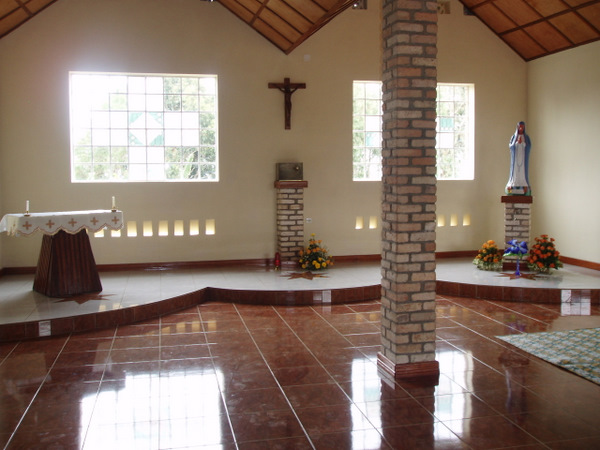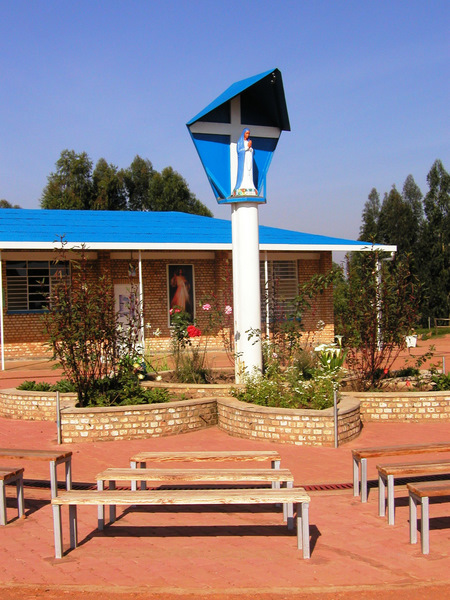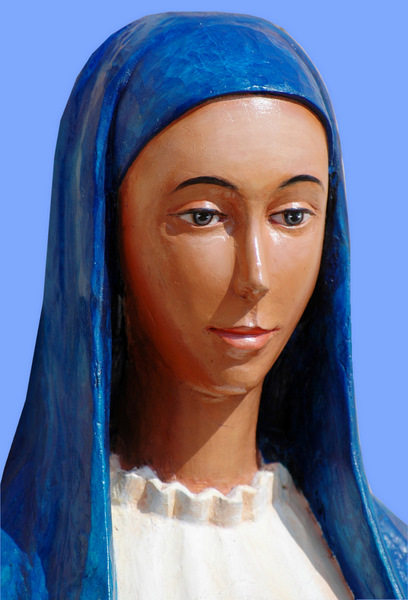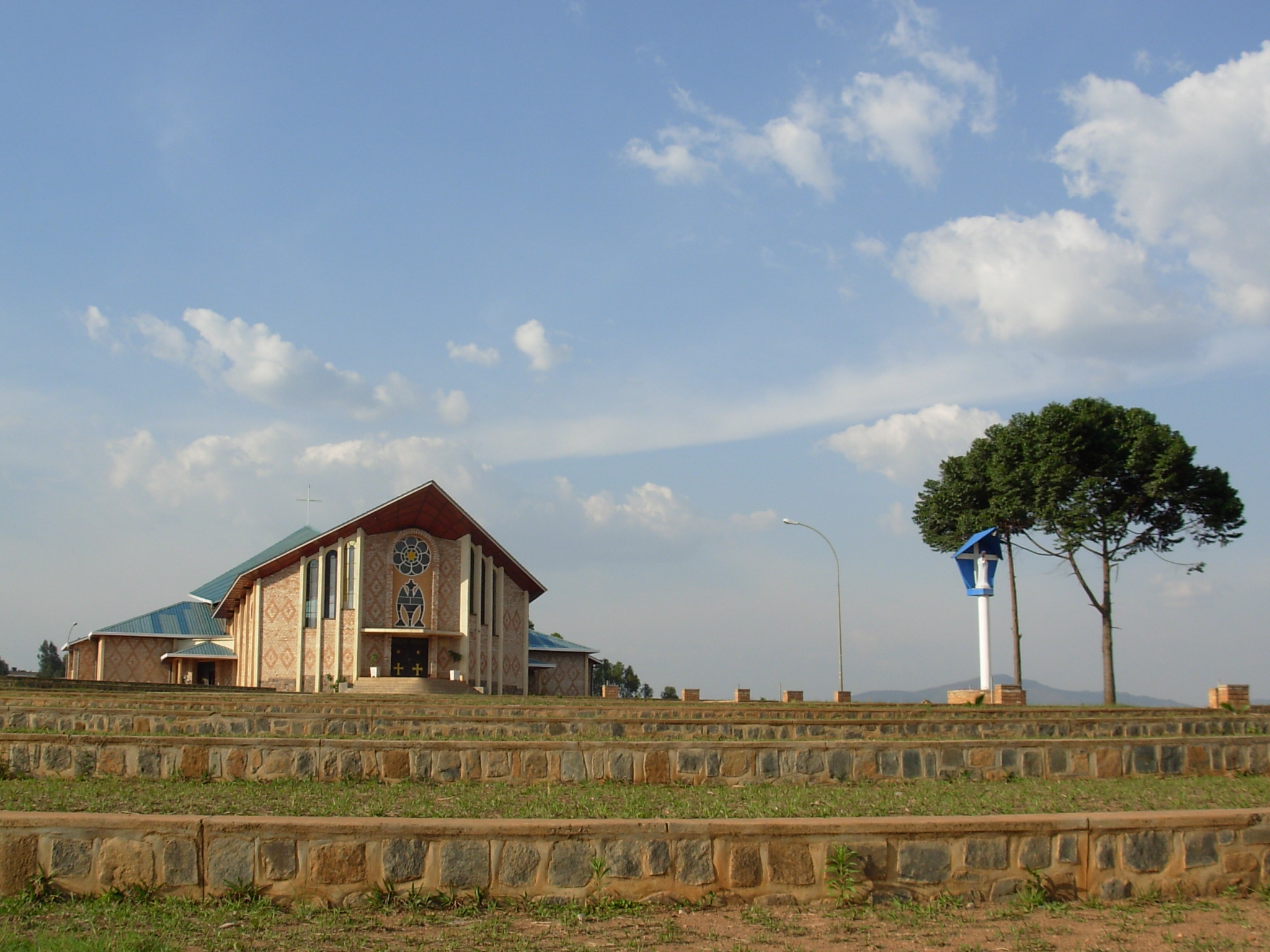Places of worship
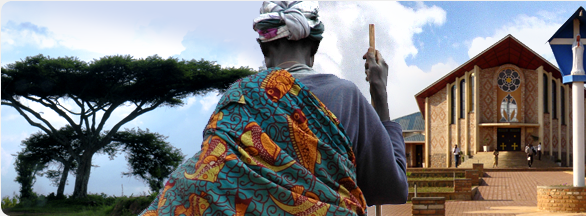
The Chapel of the apparitions
On November 20th, 1993, about one year after the laying of the first stone for the Shrine of Kibeho, the Bishop blessed and inaugurated a provisional Chapel in one of the dormitories of Kibeho secondary school, nicknamed the "dormitory of the apparitions”.
Renovated in 2007, this dormitory has been transformed into a chapel and is now known as the "Chapel of the apparitions”.
The Apparition Square
The first apparitions in Kibeho took place in the refectory and thereafter in the dormitory of the students of Kibeho secondary school.
From January 16th, 1982, on the apparitions were happening publicly outside the dormitory, in the courtyard of the school. Shortly after, due to the reads of people coming to watch and pray, problems concerning security had to be dealt with.
Despite the initiative of ORINFOR (Rwandan Office of Information) to install powerful loud speakers at the site of the apparitions so that everybody could easily follow the 'conversation' between the visionaries and the invisible person, the problem of crowding could not be solved completely.
As a reaction to these circumstances and in order to secure peace, some people willing to help voluntarily organized themselves to build a podium in the courtyard of the school with the agreement and the assistance of the bishop of Butare, Mgr Jean Baptiste Gahamanyi. This podium, surrounded by a wire fence, started to serve from August 15th, 1982 on.
Since this podium was made from wood, however, it soon met it's maker and finally disappeared completely.
The place has now become a place for contemplation and meditation with seats for more than 100 people and a statue of the Virgin Mary of Kibeho in it's center, surrounded by flowers. This place is called the Apparition Square.
The Statue of Our Lady of Kibeho
At the time of the apparitions, the investigation commissions did not hesitate to confront each of the supposed visionaries with questions concerning the identity of the celestial person they claimed to see: What exactly do you see in the apparition? Who does she resemble? How does she appear and disappear? How does she behave? How does she stand? How does she speak? Does she make gestures? How does she move? – In short, at the request of the members of the commissions, each visionary tried to describe the apparition, which was rather difficult for them.Does she make gestures? How does she move? – In short, at the request of the members of the commissions, each visionary tried to describe the apparition, which was rather difficult for them.
The work of the artists
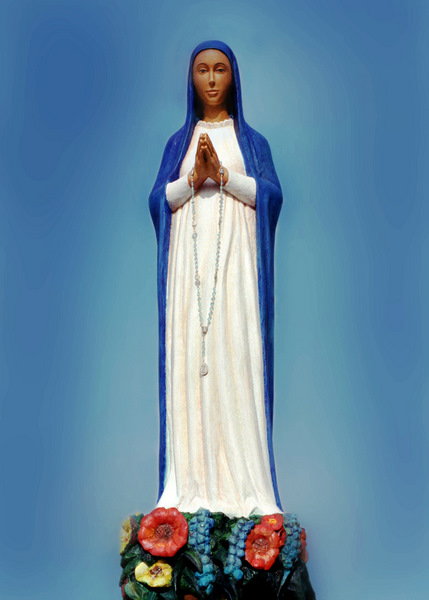
A year later, on October 22nd, 2002, another competition was organized. The project was given to the following three groups of artists:
a) Jean Marie Vianney Kabakera and Jean d’Amour Tuyisenge (from Kabgayi);
(b) Jean Pierre Sibomana and Faustin Kayitana (from Ruhengeri);
(c) Emmanuel Hakizimana (from Kigali).
All were former students of the School of Art of Nyundo, one of them even was a teacher at this school by that time.
During their work on the models, the artists could consult Nathalie Mukamazimpaka as often as they needed to. Nathalie was the only visionary remaining at Kibeho, since Alphonsine had moved to Abidjan (Ivory Coast) and Marie Claire had already passed away.
After several weeks of work, the artists presented 3 models of the statue of Our Lady of Kibeho made from clay, each about 60 cm high.
At the request of the Bishop of Gikongoro, Father Leszek Czelusniak of the Congregation of the Immaculate Conception (Marian Fathers) agreed to supervise the coordination of the groups of artists. The task was not easy for the artists, of course, because they had to closely follow the indications of Nathalie. The visionaries had always been struggling to find adequate words to describe the celestial person they had seen in the apparition.
On January 11th, 2003, a jury of experts familiar with religious arts was established to ultimately choose the best model. The members of the jury were the following:
Mr. Jean Baptiste Sebukangaga, a well-known professional sculptor of Butare;
Father Paul Bourgois, M.Afr, former member of the Commission for the Apparitions of Kibeho;
Ms. Maria Utler, a photographer at the residence of the Bishop of Butare;
Sister Césaria of the Congregation of the Little Sisters of Jesus of Rango, herself a sculptress working with clay;
Mons. Jean Marie Vianney Gahizi, Professor of philosophy at the Major Seminary of Kabgayi, draftsman; Father Joseph-Emmanuel Kageruka, Chancellor of the Diocese of Kabgayi, draftsman and
Father Leszek Czelusniak of the Congregation of Marian Fathers, photographer, painter and promoter of the Marian piety.
Nathalie Mukamazimpaka as well as the supervision group of the Shrine of Kibeho, established on November 21st, 2002, were involved in the entire process as counselors.
Under the authority of the local ordinary, the jury met for the first time on February 8th, 2003 at the residence of the Bishop of Gikongoro. After a long discussion in which the visionary Nathalie took part, the jury chose the best statue of the three models presented: The model of the two artists from Ruhengeri, Jean Pierre Sibomana and Faustin Kayitana.
The winner group was asked to still work out the details. Therefore, the artists continued their work even more seriously than before, taking into account the remarks of the jury on the one hand and of the visionary Nathalie on the other hand. After a month of reworking the statue, they presented a new model of the Virgin of Kibeho. Again, the jury brought a few aspects into consideration and suggested to still work out some details, especially on the symbolism of the flowers.
Meanwhile, in May 2003, Father Leszek, took the initiative to do order a copy in coloured wood in Rome, based on the chosen model. During the months of June and July 2003, Faustin Kayitana, one of the Ruhengeri artists, made a new statue from clay, following the two former models already existing. This time he had tried hard on the symbolism of the flowers and on the body proportions. The model was presented to the jury to obtain approval on August 7th, 2003 in Kibeho.
The jury presided by the local ordinary, embraced the model despite it's obvious imperfection: no statue of the Blessed Virgin can ever be a faithful portrait of her true self. It can always only serve as a conventional symbol. It was decided that a copy of the same statue with a height of 1.20 m should be carved in Europe, from a special and colourful wood, for the better quality of the end result. The reproduction of the statue was entrusted to a Polish artist, Marek Kowalski, Professor at the Academy of Fine Arts in Warsaw. He started carving in September 2003 and finished on November 21st, 2003.
The statue was sent to Rwanda by plane as fast as possible, for only a week later, on November 28th, 2003, the blessing and enthronement of the statue should take place at the Shrine of Kibeho
Some features of the statue
According to the note of Bishop Augustin Misago quoted above, "The Apparitions of Kibeho: A Portrait of the Virgin Mary", the visionaries described the place of meeting the Virgin Mary as paradise of stunning beauty. The Virgin Mary would stand upright, but seem not to stand on anything: she would seem to be floating! After some time, however, each of the visionaries would begin to see her in the middle of a field of flowers of different kinds and three different categories; the Virgin Mary would ask to water them. The visionaries and the pilgrims soon came to realise through the message of the Virgin of Kibeho that the three categories of flowers represent the people of Kibeho as they are before God.
The more “the field of flowers” was expanding in the visions, the more the speed of "conversions" is accelerating, we can conclude, up to the point when the community of faithful becomes like one huge field of flowers. Hence, the flowers on which Mary floats constitute one of the distinctive features of the statue of the Virgin Mary of Kibeho.
The Blessed Virgin appeared as an extraordinary lady, beautiful and entrancing. The colour of her skin was described as neither white nor coloured, but something in between. From her body only the face and the hands were to be seen, as the rest of the body was hidden by her garment. According to Nathalie, Our Lady was dressed in two colours, wearing a white dress and a sky blue veil in the form of a mantle covering her from top to toe. The Virgin Mary usually stood with her hands folded on the chest like in prayer with her fingertips indicating towards her chin, her head slightly bent to one side, like a mother looking with tenderness at her child standing before her. Nathalie said that she had also seen her standing with open arms and her hands stretched out towards the ground. In the sculpture of the statue, however, we opted for the position with joined hands.
The visionary Marie Claire Mukangango said to have received revelations about the Rosary of the Seven Sorrows of the Virgin Mary. The blessed Virgin loves this rosary. Well known in the past, it had been forgotten. Our Lady of Kibeho wishes it to be brought back into practice and to be spread throughout the Church. For that reason the Virgin Mary of Kibeho holds this rosary suspended from her joined hands.
The day of November 28th, 2003, the twenty-second anniversary of the apparitions of the Virgin Mary of Kibeho, was particularly marked by the blessing and enthronement of the statue of Our Lady of Kibeho in the Sanctuary. Of course, this statue is not a photograph of the Virgin Mary "Nyina wa Jambo", even if some of us would like it to be; it is simply a work of art made by human hands. There is no life or divine power in it. It is only a symbol that should encourage our hearts to rise towards the truth of heaven and to contemplate the One this symbol refers us to.
In his homily in honour of this celebration, Bishop Augustin Misago said: “According to the teachings of the Council of Trente in 1563, which is still up to date, the Church recommends all Christians to possess and honour in churches as well as in the families, statues and images of Our Lord Jesus Christ, the Virgin Mary and the saints. The Council further says, that if we venerate these images, it is not because they carry in them a divine power which would lead us to offer them sacrifices and prayers as the pagans did to their idols (Ps 135, 18). In reality, we venerate in them what they represent: Jesus Christ and the saints. This teaching should be continuously taught to all Christians in order to protect them from getting trapped in idolatry."
Kibeho with its message, its Shrine, and with its statue of Mary Mother of the Word has been consigned to the history of the Church. Now we are writing a new page of God’s wonders each day of our lives, in honour of Mary Mother of the Word, in this very place, chosen by her forever.
The Church of Our Lady of Sorrows
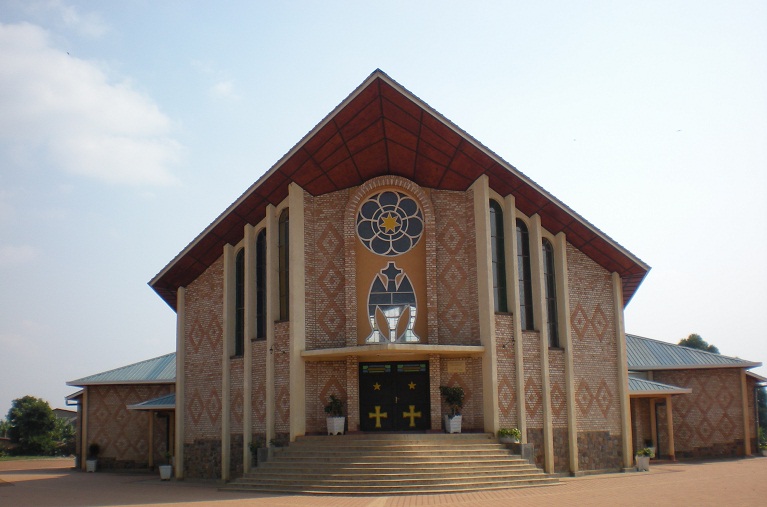
Among the elements of the message of the Virgin Mary “Nyina wa Jambo” there is in particular the appeal to build a chapel at Kibeho in remembrance of her apparition at this blessed place. On this issue, the local Bishop
expressed himself in his declaration recognising the apparitions on June 29th, 2001, as following:
"The message of the Virgin Mary to the visionaries of Kibeho, contains, among other aspects, the wish that we should build a Shrine at Kibeho in her honour and in remembrance of her
apparition in that place. This message first received by Alphonsine during the apparition of January 16th,1982, was repeated several times that year. This message was given by the Virgin Mary not on her own initiative, but as a response to a request from the visionaries.
We must recognise that the talk of the visionaries with the Virgin Mary didn't contain the word "basilica" at all. Our Lady rather talked about a chapel (Bikira Mariya ngo arashaka shapeli). The concept of the "Basilica” is a totally strange element in the true message of Kibeho. None of the three recognised visionaries has ever used this word.
The idea comes instead from a book on the Kibeho apparitions published in February 1983 and distributed free of charge in some places.
Furthermore, the message concerning the construction of a chapel at the place of the apparitions in Kibeho does not limit the Bishop to certain dimensions, plans, shapes or arrangements of the building. The words attributed to the Virgin Mary rather leave him freedom to act fulfilling the pastoral ministry to his faithful.
At last, even if the Virgin Mary had not asked us to build a chapel, this would have imposed itself as soon as public worship would have been established in this place.”
Although the foundation stone of the church was laid on November 28th, 1992, the official construction only began on January 12th, 2002, due to the genocide of 1994. The blessing and the official inauguration of the Shrine of "Our Lady of Kibeho" took place on May 31st, 2003, on the feast of the visitation. On invitation by the Episcopal Conference of Rwanda, the liturgical ceremonies were presided by His Eminence Cardinal Crescenzio Sepe, who was prefect of the Congregation for the Evangelization of Peoples by that time. A great event long awaited by the faithful.
This new house of worship is called the "Church Our Lady of Sorrows". Why this name? The local ordinary explained this in his homily on September 15th, 1996, at Kibeho:
"As I have already mentioned at different occasions, I chose to call the Marian shrine of Kibeho "The Shrine of Our Lady of Sorrows". Most of the contents of the message of Our Lady Mother of the Word that the visionaries of Kibeho received during the apparitions, especially the one from January 1982, dealt with the theme of suffering and its place in the life of Christians. The people of Kibeho adopted this message as their own and thus the Rosary of the Seven Sorrows of the Virgin Mary. In addition, each and everyone, without exception, was urged to do penance and mortification, to make renunciations, to withstand all temptations in expiation of the sins of the world and to intimately participate in the passion of Jesus for the redemption of people. All those who observed the apparitions of Kibeho from nearby, for example on August 15th, 1982 (feast of the assumption), are obliged to recall the facts that marked the occasion that day and during the following months: The tears of the Virgin Mary, visionaries fainting after they had had the visions, the fasting, all kinds of sorrows, …
Another point to consider is the elimination of the people of Kibeho, and many other parts of the Great Lakes region due to ethnical and political reasons. People lost their lives or all human rights. Many people have suffered a great deal – and lots of them are still suffering. Therefore, Kibeho is a place that should never seize to remind us of the cross of Jesus in the life of each and every Christian as well as in the community of the Church for we are called to follow Jesus on the way to Calvary.”
In the book of the Apocalypse of St. John, we often come across the numer “seven”. This number, symbolising fullness or multitude, was also represented in the apparitions of Kibeho through the seven sorrows of the Virgin Mary. Thus, the number seven is also represented in the structure of the Marian shrine of Kibeho: Both facade windows, the large rosette and the crosses on the walls evoke this symbolism.
The Church of Our Lady of Sorrows offers space for 800 to 1000 faithful. Its relatively limited capacity is not only explained by the lack of funds for a larger building, but mostly by the lack of space – a crucial question for the future development of the shrine.
In 2007, the church was reconstructed, since some of its parts needed to be repaired.
The Esplanade of the Shrine
Since the beginning of the apparitions until today, Kibeho has been frequented by crowds of people. To welcome them there needed to be found a big enough public open space. The more the crowds increased, the more the esplanade of the shrine expanded both in largeness and infrastructure. Today, as the construction of the shrine is completed, the esplanade is capable of receiving up to 60 000 pilgrims. It also comprises a podium for big celebrations, a garden for meditation, and a small parking lot for vehicles. On the avenue leading through the esplanade, a statue of the Virgin Mary welcomes the pilgrims.
The calvary and the way of the cross
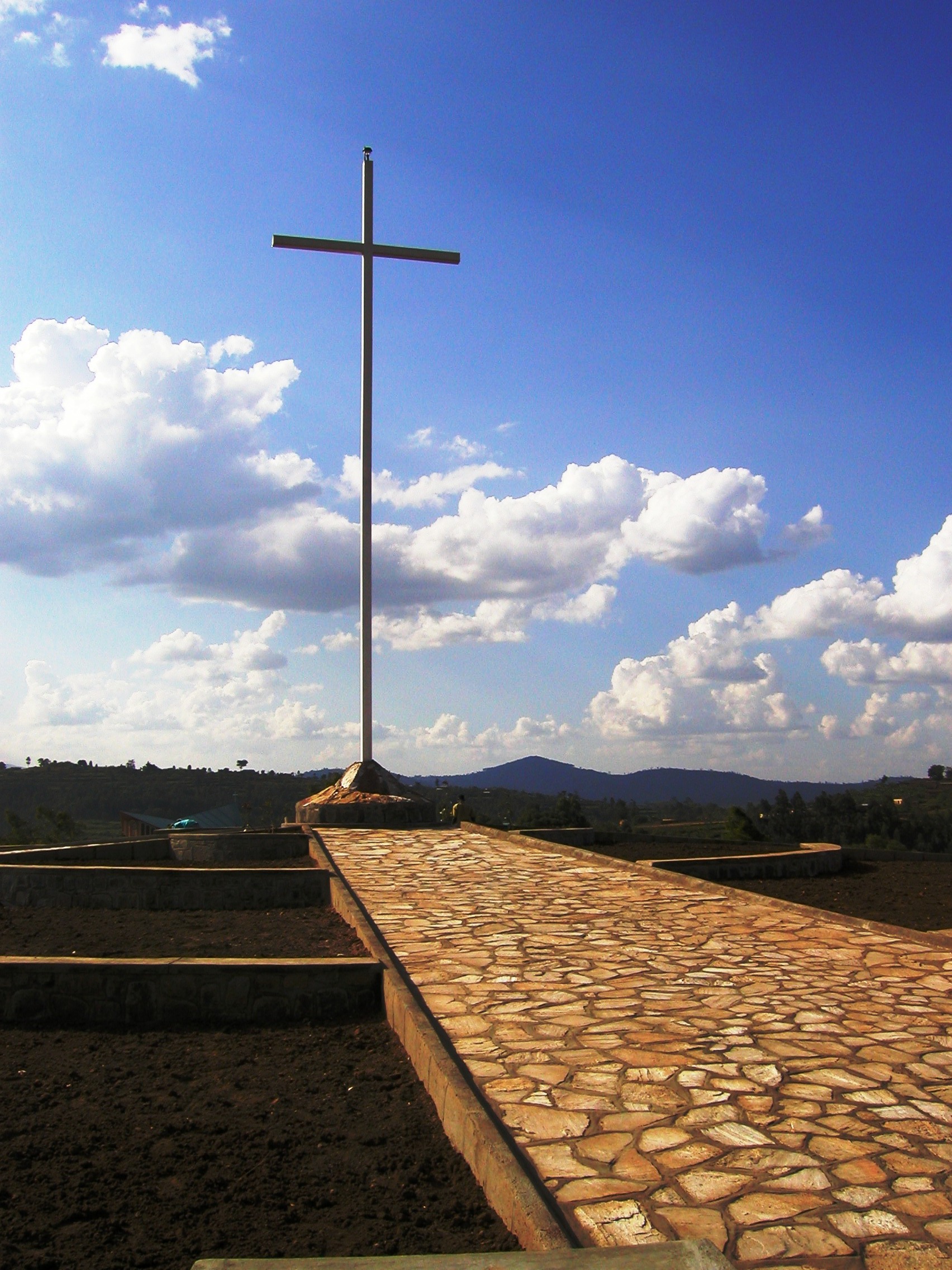 As generally known, the theme of suffering, of the cross, is one of the most important themes in the history of the apparitions of Kibeho. This applies especially to the visionary Nathalie Mukamazimpaka. For a Christian, suffering is inevitable in his or her present life here on earth. It is an essential path to get into the glory of heaven. The Virgin Mary said to the visionaries, particularly to Nathalie, on May 15th, 1982: "Nobody enters heaven without suffering." Or also: "The child of Mary does not discard suffering." Suffering is also a way to atone for the sins of the world and to participate in the suffering of Jesus and Mary for the salvation of the world. The visionaries have been invited to live this message in a practical way; to accept suffering in faith and joy; to mortify themselves (kwibabaza) and abandon pleasure (kwigomwa) for the conversion of the world. Kibeho is therefore a reminder of the place the cross should maintain in the life of a Christian and of the Church. Thus, in 2006, we built a way of the cross leading onto a hill near the shrine, the “Calvary”, the top of which is marked by a large cross.
As generally known, the theme of suffering, of the cross, is one of the most important themes in the history of the apparitions of Kibeho. This applies especially to the visionary Nathalie Mukamazimpaka. For a Christian, suffering is inevitable in his or her present life here on earth. It is an essential path to get into the glory of heaven. The Virgin Mary said to the visionaries, particularly to Nathalie, on May 15th, 1982: "Nobody enters heaven without suffering." Or also: "The child of Mary does not discard suffering." Suffering is also a way to atone for the sins of the world and to participate in the suffering of Jesus and Mary for the salvation of the world. The visionaries have been invited to live this message in a practical way; to accept suffering in faith and joy; to mortify themselves (kwibabaza) and abandon pleasure (kwigomwa) for the conversion of the world. Kibeho is therefore a reminder of the place the cross should maintain in the life of a Christian and of the Church. Thus, in 2006, we built a way of the cross leading onto a hill near the shrine, the “Calvary”, the top of which is marked by a large cross.
The Way of the Rosary
One of the elements of the message of Kibeho is the "devotion to Mary". This devotion must be reflected on through regular and sincere recitation of the rosary. To help the pilgrims put the message of the Virgin of Kibeho into practice, we installed a way of the Rosary in 2006.
The Way of the Rosary of the Seven Sorrows of The Virgin Mary

As Our Lady of Kibeho wishes the Rosary of the Seven Sorrows of the Virgin Mary to be brought back into practice and to be spread throughout the Church, of course without suppressing the Holy Rosary, a way of the Rosary of the Seven Sorrows was included into the infrastructures of the Shrine "Our Lady of Kibeho" in 2006.
It offers the possibility to put into effect what the Mother of the Word requested of the pilgrims: To recite the Rosary of the Seven Sorrows.
The Chapel of Reconciliation (Project in course of realisation)

Mons. Augustin Misago, local ordinary, put the whole purpose of having a chapel of reconciliation at Kibeho into very beautiful words:
"Thank the Lord and the Blessed Virgin Mary for giving us this blessed place of Kibeho, where pilgrims can work on the conversion of their hearts, and be restored to the waters of salvation of the sacraments of reconciliation and of the Eucharist. This Marian shrine should be a privileged place for the new evangelisation of Africa. I therefore encourage you to come frequently in carefully prepared pilgrimages to this place of worship. (…) Pray together to Our Lady of Kibeho, Mother of the Word, so that justice, forgiveness, reconciliation, peace and stability may increase ever more abundantly and remain forever in Rwanda and the other countries of the Great Lakes region. Amen. »
The Chapel of the Holy Sacrament (Project under examination)
It is important to note that devotion to the Blessed Virgin Mary must go hand in hand with unconditional love towards Jesus and our neighbour. Indeed, Mary, our mother, teaches us to love Jesus as she loved him. Hence she wishes that we love Jesus more and more, him, who is the way, the truth and the life (Jn 14.6). To achieve this goal, the adoration of the Holy Sacrament is of great importance to the pilgrims.
The Source of water
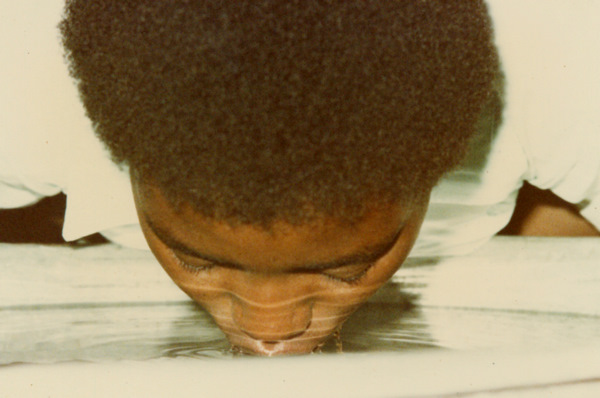
The ceremony of the blessing of water in Kibeho was initiated for the first time on March 2nd, 1982. The visionaries made clear, that, through them, this blessing was given by the Virgin Mary herself. The blessing was given to the faithful who had come to Kibeho in order to receive a blessing as well as to objects brought for the same purpose.
According to the testimonies of people present and to documents of this time, Kibeho had an acute problem of water shortage. In this context, the Virgin Mary asked Alphonsine on January 16th, 1982, to be water "her flowers", that is the people present, Alphonsine replied: "Mother, although we need to walk a long way to fetch water in Kibeho, I will do my best to find water to water them."
Despite the problem of water shortage at Kibeho, however, the blessing of water has been done ever since, and "the flowers of Mary" have been watered. According to Alphonsine as well as Nathalie, two of the visionaries, the blessed Virgin inaugurated the blessing of water during the apparition on March 2nd, 1982, including further explanations concerning e.g. the protection against attacks of demons.
These explanations were given as a result of the problems that Marie Claire, the third visionary, had had, which made people think she was attacked by demons:
During the apparition on March 2nd, 1982, Nathalie spoke about the problem of demon attacks and asked Our Lady how to fend them off. The Virgin Mary answered that, to defeat Satan, "we need to maintain the force of prayer without hypocrisy and to persevere on the path of conversion of the heart".
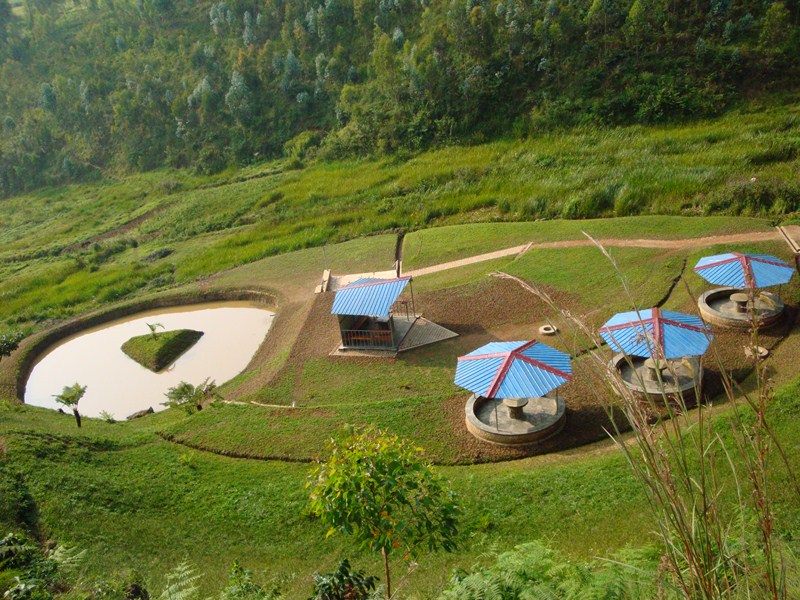
Nathalie was not entirely satisfied with this response, so she asked again if there was something else to be done in order to chaise the demons and bring back peace to their school. In the meantime, Sister Blandine had asked to bring some water to the site of the apparition. After a short song in honour of Mary, the blessed Virgin asked Nathalie what purpose the bucket of water should serve. Nathalie answered that she did not know. The two of them continued their dialogue to the point where the Virgin Mary blessed the water as well as all the rosaries there. During the following apparitions, Nathalie gave further explanations on the blessing of water and stated that "the holiness of the Virgin Mary was symbolised by the water which She Herself has blessed – water that gives patience, strength, consistency, power and courage."
After having understood the meaning of holy water, the visionaries began to ask the Blessed Virgin Mary on April 30th, 1982, to create “a source of miraculous water at Kibeho which should continuously flow and benefit to all who should use it. In reply to this request, the Blessed Virgin Mary said: "I give how I want and when I want." During the apparition to Alphonsine that very day, the Virgin Mary asked why Nathalie kept asking for an inexhaustible source of water. Alphonsine replied: "I do not doubt that she (Nathalie) has good reasons to ask for water. I personally think that a source like that would be very useful for us, especially if it were to come from you.”
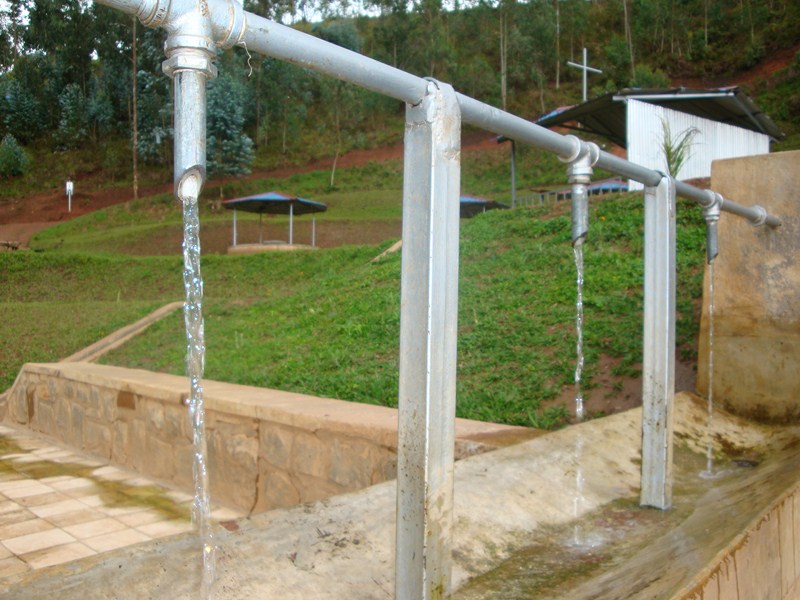
In the course of the following month, Alphonsine and Marie Claire followed Nathalie's example and asked the Blessed Virgin Mary for an inexhaustible source of holy water. On May 31st, 1982, this topic was brought up again. In a long dialogue between the Virgin Mary and Nathalie, Our Lady asked again why Nathalie was insisting on the question of water. Nathalie answered that this water would be very useful for a large number of people.
Finally, the Blessed Virgin Mary promised "water" to Nathalie, but water different than requested. She said decidedly: "Patience! Even if you shall not have this source of water today, you shall have another kind of water which will quench your thirst". After this, the Blessed Virgin specified: "Do not doubt, I will give you water – I won't give you a source, but water.”
During the following apparition the same day, Alphonsine said that she felt hot and thirsty. Hence, she began to ask for water. In the afternoon, Kibeho was showered by heavy rain. Nathalie, who was still lying on the ground in a state of ecstasy, learnt from the Virgin Mary that she had kept her promise. That very moment, Nathalie realised that she was soaked by the rain.
That day, those who expected that the Blessed Virgin would perform a miracle by providing a source of water, went away empty-handed, because the Virgin Mary had refused to perform a miracle the way the visionaries wanted it. From that time on, however, the apparitions of Kibeho were marked by rain called the rain of blessing or the blessing of the Virgin Mary.
On June 24th, 1982, the last time that Nathalie asked for "an inexhaustible source of holy water", the Virgin Mary replied: "Not only the water you ask for contains blessing (…), my blessing emanates from any of my signs (…).”
In short, the Virgin Mary did not agree to perform the miracle of installing a source of holy water at Kibeho. Thus, the place at Kibeho called "Source of Mary" is not a source that the Blessed Virgin Mary had miraculously made spring up. It is an old source which was simply developed into a standpipe.
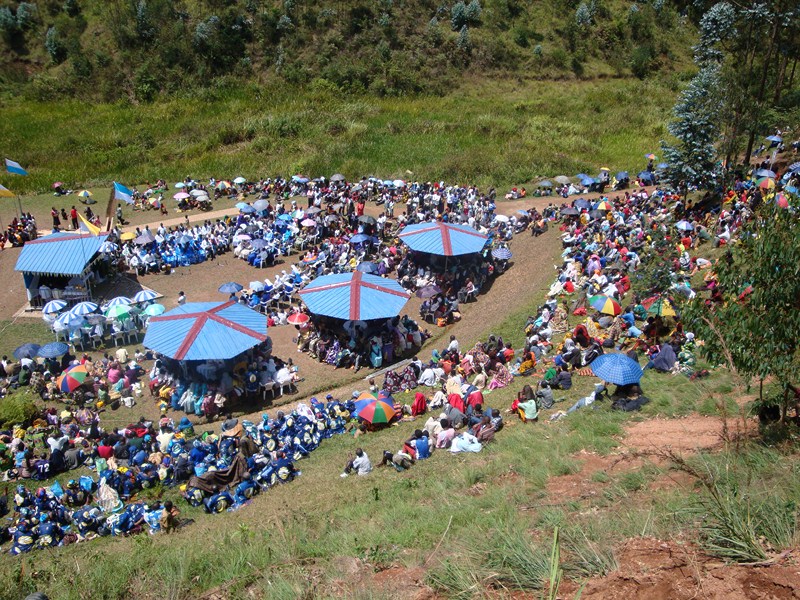
The main reason for naming this place the “Source of Mary” is, on the one hand, the mere the fact that this water comes from the hill on which Mary appeared. Since the blessed Virgin Mary chose this very hill to be her dwelling place, we take it that the source of water emerging from it also belongs to her. On the other hand, attributing the source to Our Lady was a logical result due to the major problem of water shortage at that time mentioned above: Up to today the “Source of Mary” is serving the children of the Blessed Virgin.
On 14th August 2011 in Kibeho during the Eucharistic celebration led by Vicar General Diocese of Gikongoro Ntagandy Edouard, took place blessing of new builded spring dedicated to Holy Mary Mother of the Word. Eucharist was celebrated around the source, in a valley at the foot of the hill, where is developing the shrine of Our Lady. The vicar-general in his homily returned to the theme associated with the revelations of holy water.
Garden of Our Lady and the processional way


Near the shrine, on the road coming down to the spring, there is a "Garden of the Blessed Virgin Mary." It consists of flowers, trees, and paths. There are also benches where you can sit and contemplate.


The garden also refers us to the theme of flowers and trees in the apparitions in Kibeho. At the time of the apparitions the girls stayed outside our world. There were also in heaven. Seen among the trees or the flowery fields. At the request of the Blessed Virgin Mary they watered "flowers" or "trees" of different species and quality. These "flowers" and "trees" were symbols of the people receiving the message of the Virgin Mary: the more conversions, the more increases of the 'field of flowers ". We made a new processional way that is passing in the territory of the Sanctuary. You can already use this road. We made a new processional way that is passing in the territory of the Sanctuary. You can already use this road. It runs partly through the garden of the Blessed Virgin Mary, which is a novelty in Kibeho.




